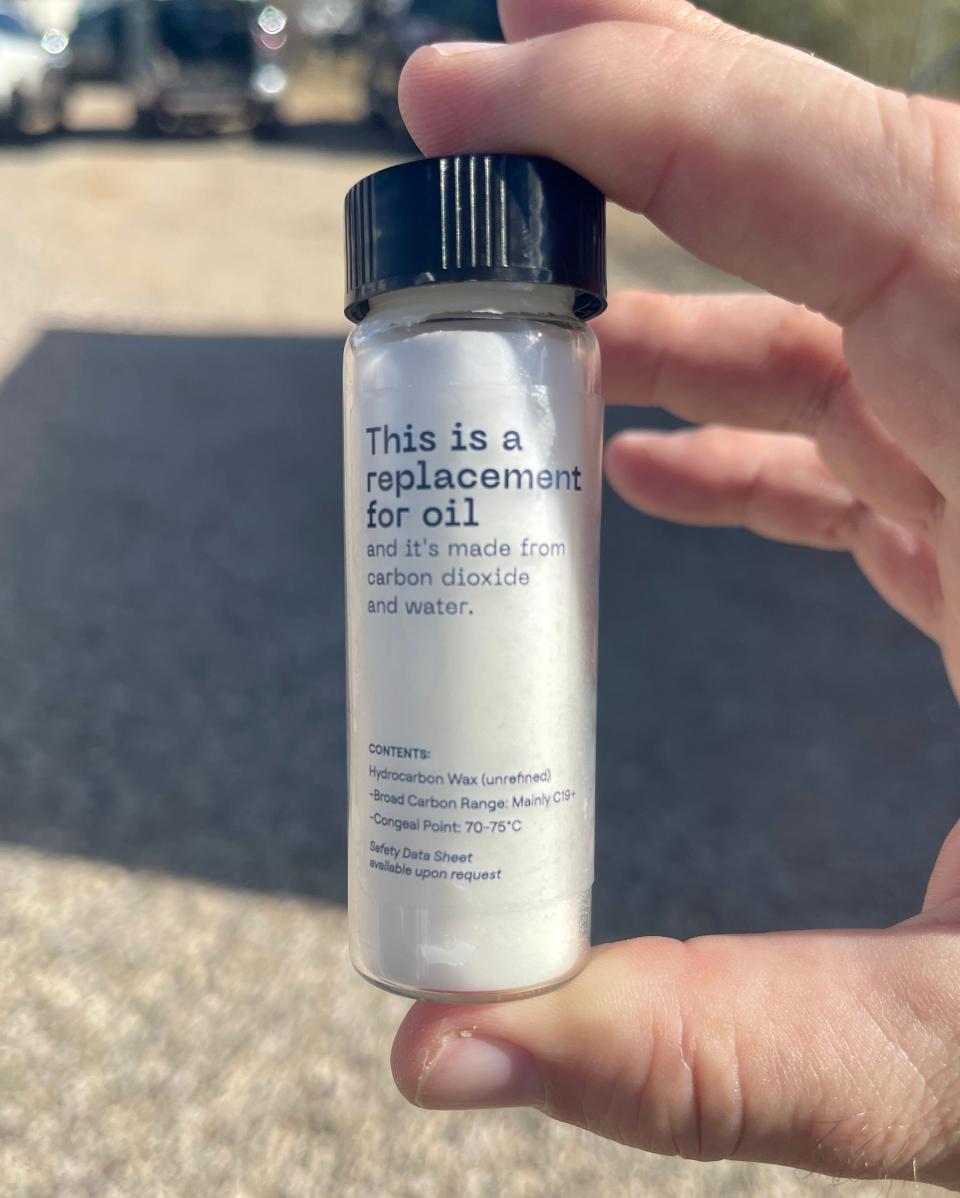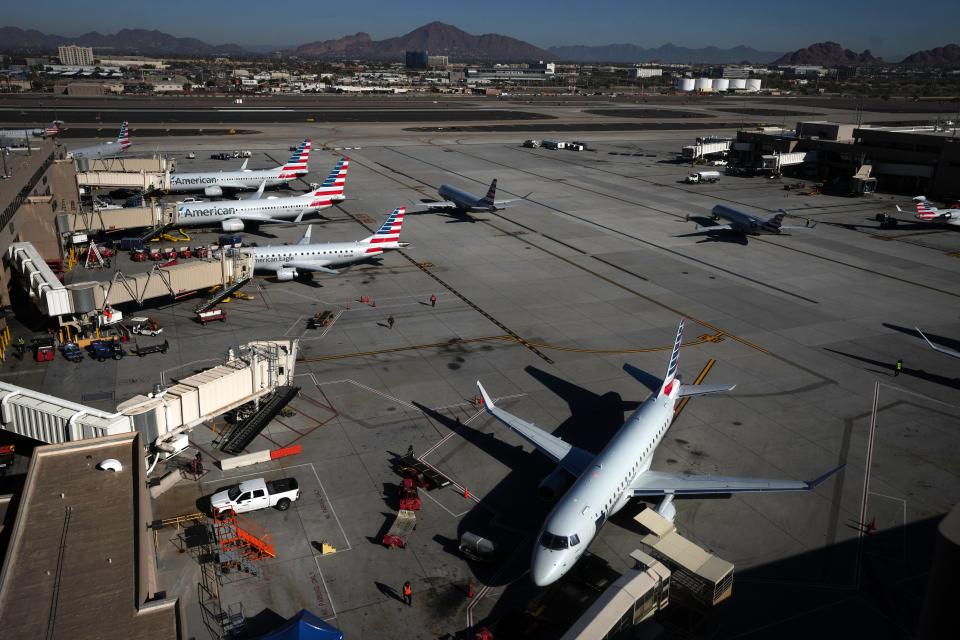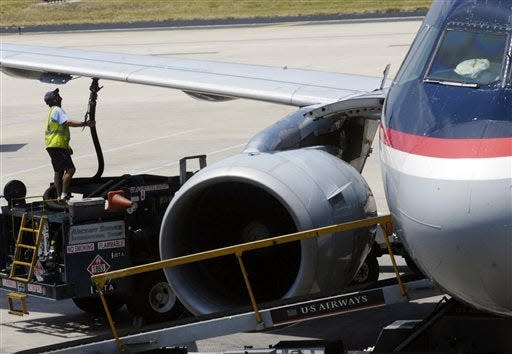Grass for gas? Researchers, businesses weigh options for sustainable aviation fuel

On a recent breezy December afternoon, Jason Salfi, CEO of Dimensional Energy, took the stage at the University of Arizona Tech Park in Tucson donning a big smile and a white hard hat. He was there to cut the ribbon on the company's new project to help decarbonize aviation, one of the trickiest sectors to emancipate from fossil fuels.
Addressing the audience, Salfi expressed gratitude for his business partnership with United Airlines Ventures and acknowledged representatives of the Tucson mayor, a congressman and Arizona's U.S. senators, whose attendance he viewed as a show of support for their "first-of-a-kind facility." He expressed a dream of someday making fuel for the Tucson airport.
Then he thanked the Earth "for providing the molecules that we use to make the green fuels that we would like to provide for you all."
On its website, Dimensional Energy says its purpose is to "transform carbon dioxide into sustainable aviation fuel." The company calls its technology "a regenerative system, inspired by nature." Essentially, the company's equipment captures carbon dioxide from the air, or directly from industrial emitters, before it ends up as a warming gas in the atmosphere and transforms those harmful molecules into hydrocarbons useful as fuels or other products using "proprietary catalysts" in its reactor.
In airplane terms, the process happens in a bit of a black box, but Dimensional Energy is already making what it calls flight-ready sustainable aviation fuel, or SAF, along with waxy hydrocarbon products that can replace petroleum in the manufacturing of certain textiles and construction materials. And whereas direct air capture technology has drawn criticism for being counterproductively energy intensive, the facility at UA's Tech Park pulls carbon dioxide emissions straight from the flue of a cement plant, helping to make the process cleaner and more energy efficient.
"Sustainable hydrocarbons allow us to use the existing infrastructure designed to run on hydrocarbons (for example, for aviation), yet hydrocarbons produced from carbon dioxide will not add new carbon dioxide to the atmosphere," Salfi told The Arizona Republic. "As we transition from extraction, we will continue to need carbon-based molecules synthesized sustainably.”

Later at the event in Tucson, Dimensional Energy board member Eric Rubenstein held up a glass jar of jet fuel that had been produced on-site. The company has big plans for scaling up to many more jars. Right now, it produces 5 gallons of SAF in Tucson per day. With other facilities soon to join the effort, it expects to generate 84 gallons per day by the end of 2023, to increase that 100-fold by 2025 and to "fuel global air travel" with more than 42,000 gallons per day by 2027.
United Airlines has helped shape this aggressive timeline by committing to purchase at least 300 million gallons of Dimensional Energy's SAF over the next 20 years. But the transition away from fossil fuel use in aviation — currently responsible for 10% of U.S. greenhouse gas emissions from transportation and 3% of its overall emissions, according to the Environmental Protection Agency — will depend on more than just how fast one company can turn cement byproducts into flight fuel.
Real cause?How much of the heat can we blame on the heat island?
Scaling up or stalling out on SAF
Right now, a United Airlines flight taking off from Sky Harbor International Airport in Phoenix is 100% fossil-fueled. That's because, although the International Air Transport Association has authorized jet fuel blends of up to 50% SAF, Sky Harbor does not offer SAF on-site for planes to use to refuel.
An airport representative said in a statement to The Republic: "Phoenix Sky Harbor does not currently store or distribute SAF. This is very much a developing and emerging area. We have identified in our Net Zero Carbon Roadmap that we will support the airlines in pursuing SAF at Phoenix through understanding their infrastructure development needs and fuel feed-stock availability."

A map made by 4air, an organization dedicated to issues in aviation sustainability, suggests that only about 40 airports nationwide have the infrastructure to offer SAF, more than a decade after the first successful test flight in 2008.
Part of that is simply because there isn't currently much SAF to go around. IATA reported that, in 2021, airlines purchased "every drop of the 125 million liters (33 million gallons) of SAF that was available." That's a far cry from the U.S. Department of Energy's goal under the Biden administration of producing 3 billion gallons of SAF per year by 2030 and 35 billion gallons per year by 2050. Much of the SAF available now is made from waste products like used cooking oil, referred to as "feedstocks," the supply of which cannot keep up with air travel's fuel demand.
"I don't know about the rest of you, I like french fries, but I'm not eating more french fries, and I am traveling more," said Michael Leskinen of United Airlines Ventures at the UA Tech Park event. "The price of that feedstock is being bid up, so the cost of sustainable aviation fuel when you buy more of it doesn't go down. You can't have $12 a gallon jet fuel and have United Airlines connect people and unite the world, which is our mission."
This hang-up in the hangar has sent researchers scrambling to figure out new ways to speed up economical production of sustainable aviation fuel, defined as any flight-compatible fuel that is produced in a truly sustainable way without lasting impacts to the Earth or the climate.
Is overpopulation the problem?Welcome to a new year on a warming planet, now with 8 billion people
Grass-powered flight?
In November, a team of scientists based at Arizona State University published a paper in the journal Nature Sustainability on the viability of biojet fuel in terms of land-use sustainability. They argued that the United States' projected 2040 jet fuel demand of 30 billion gallons per year could be met by planting 23.3 million hectares, roughly the area of Wyoming, with a grass that can be harvested and turned into a version of SAF.
Their model factors in geographical, ecological and social limitations like water availability, land use and economics and proposes planting miscanthus, or "elephant grass," across the wetter eastern U.S. on marginal agricultural lands. Filling in these unused patches surrounding existing fields might also result in the beneficial grass absorbing excess fertilizer, pesticides and herbicides sprayed on nearby crops like corn and soy before they run off those fields and into the water supply.
Elephant grass has to be planted as rhizomes, an underground plant structure similar to roots, and therefore is not likely to spread and become invasive, as other grasses have across the desert Southwest, worsening wildfires. The researchers showed that it would not diminish soil moisture and could even improve local climates, providing some regional cooling effects as it absorbs carbon dioxide from the atmosphere during photosynthesis.
"There are environmental and economic benefits of having a system like this," said Nazli Uludere Aragon, the lead author at ASU on the study and now a postdoctoral researcher with the Environmental Defense Fund. "It doesn't require as much chemical input, as far as we know, to grow. And just because of their perennial nature, (the grasslands) become more of a habitat to wildlife than annual crops."

These perennial crops should also be much harder to disrupt than some traditional crops being hammered by increased flooding caused by climate change in the Midwest. A deep-rooted perennial crop has to get established, but after that it should be more durable to something like a flood or a drought, said Nathan Parker, an assistant professor at ASU's School of Sustainability and an author on the paper.
“You have to put a lot of money in that first year to get it going. But then it's relatively cheap to operate," Parker said. “We modeled it as an annual harvest cycle, but there can be various ways that folks have thought about doing this. You can try to spread out your harvest to time it for deliveries so you don't have to have as much storage. But it’s going to be continuously harvested annually, possibly twice a year to make it work."
Their paper estimates that elephant grass crops could meet U.S. SAF demand by 2040 at a competitive, average price point of $4.10 per gallon. This would require quick action to get suitable lands planted and the appropriate infrastructure in place, but the researchers think it could be a solution to current constraints on SAF production related to carbon capture technology and availability of feedstocks.
"We were able to demonstrate in this paper that we could (produce SAF from grass) for the whole country," said Uludere Aragon. "There are other pathways to producing SAF. And I actually think it’s great that there are lots of technologies like air capture getting explored for climate innovation. But I don’t know how air capture to sustainable fuel would work for the entire country."
Race to the skies
With the demand for global air travel projected to soon exceed pre-pandemic levels and calls growing louder for climate action to reduce warming emissions from burning fossil fuels, the race to reform flight is on.
Electric planes exist but are currently limited to short, lightweight flights due to the heft of lithium batteries, the availability of which is also an issue. But as battery technology evolves rapidly alongside SAF, this may become another area of innovation to watch for in the skies.
"With battery technology today, we're going to be able to decarbonize regional, short haul flights, those 200 to 400 mile trips with 30 seats," said Leskinen of United Airlines Ventures. "But with the energy density of jet fuel, the only real way to solve this problem is with sustainable aviation fuel."
More in the climate change series:The latest from Joan Meiners at azcentral, a column that publishes weekly
Tomorrow's pilots are already thinking about SAF as the future of air travel. At Embry Riddle Aeronautical University, the nation's top aviation program with a campus in Prescott, students expect to fly with it someday.
"I think that absolutely our students are excited about it," said Parker Northrup, the department chair of flight and an assistant professor of aeronautical science at Embry Riddle. "Many of them are patient in terms of when. They understand there's a process to get there. But certainly they're excited about it eventually getting fielded across the U.S."
But they don't yet have the opportunity to train with it. Northrup said the availability of SAF and the modest modifications that would be necessary to use it in the type of engines on the school's aircraft have meant that student familiarity with SAF is still more in theory than in practice.
They are trying to change that. Throughout his career in this hard-charging, high-flying field, Northrup has become "pretty comfortable with change and change management," pending safety precautions. He expects SAF use to become widespread soon and says his students are ready for it.
“To use a baseball analogy, I’d say we’re on deck," he said. "We’re ready to get up there, but we just don’t quite have all the things lined up to do it today. Until it’s available consistently, we can’t go down that road."
As far as the race between electric-powered flight and sustainable aviation fuel availability, Northrup agreed with Parker of ASU and Leskinen of United Airlines Ventures that SAF viability is slightly ahead of battery technology for the future of commercial air travel.
Embry Riddle is engaged with industry partners that are developing electric technologies, especially in the light, commuter and the trainer aircraft environment, he said. But because existing battery weight-to-energy-density ratios don't allow for lift, he doesn't expect to see a viable trainer aircraft become economically feasible before 2027 or 2028.

No matter who wins the race to the commercial skies — electric batteries, direct carbon capture into SAF or biofuels from sources like elephant grass — the progress being made to reduce the impact of emissions from air travel on the climate seems a bright, shining light ahead.
As grateful-for-molecules Salfi put it onstage in Tucson:
"If you take a step back and think about that for a second, we could use past emissions to actually make the fuels and products that we use every day with clean energy and carbon dioxide," he said. "That's a really marvelous thing. That is part of the solution."
Joan Meiners is the climate news and storytelling reporter at The Arizona Republic and azcentral. Before becoming a journalist, she completed a doctorate in ecology. Follow Joan on Twitter at @beecycles or email her at joan.meiners@arizonarepublic.com.
Support climate coverage and local journalism by subscribing to azcentral.com at this link.
This article originally appeared on Arizona Republic: How sustainable aviation fuel could help address climate change
